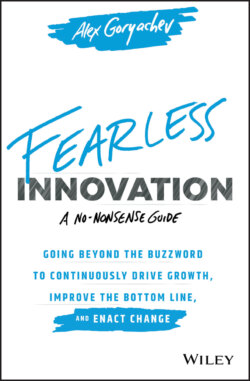Читать книгу Fearless Innovation - Alex Goryachev - Страница 19
Case Study: LEGO
ОглавлениеMy five-year-old son Matthew is crazy about his LEGOs. I find them all over the house—the living room, his bedroom, the kitchen, the bathroom (specifically the bathtub, which came with a $90 bill from a plumber)—there seems to be an endless supply. Matthew’s favorite pastime is to put them together in all sorts of shapes with my wife, Maria. Needless to say, LEGOs are high on my personal radar, mostly as walking hazards covering the floor. But there’s another reason I’m interested in them. LEGO is a great example of a company that intimately understands that innovation is always constant, urgent, and time-sensitive.
It may seem ironic that with all this talk of the technological advances of the Fourth Industrial Revolution and the changing world around us, LEGO—whose flagship interlocking plastic bricks began production in 1949—is a prime example of these principles. Before you jump to conclusions, consider that children around the world spend 5 billion hours a year playing with LEGO bricks.43 Since 1949, more than 400 billion of these bricks have been produced. As for their minifigures, they sell 3.9 of them per second, every day of the year. That adds up to over 122 million of these little guys and girls annually. If that doesn’t pique your interest, then this will: in 2018, in opposition of toy industry trends, LEGO increased its market share in all major markets, with its revenue growing 4 percent to around $5.5 billion.44 Oh, and Ryan of Ryan ToysReview reportedly loves LEGOs as well.45 Coincidence?
In 2003, with LEGO on the verge of bankruptcy, no one would have guessed that the company would be reporting such strong earnings or be dubbed “the Apple of toys” sixteen years later.46 Facing major competition in the 1990s from a new wave of video games and computers, paired with shrinking independent toy stores around the world, LEGO took the “ignore it” approach, hiding behind a false confidence in what the company termed its “classic market” position and failing to take action or even admit that the industry was being disrupted.47
In time, leaders across LEGO started to realize that if they wanted the company, and their jobs, to survive, a new approach was necessary. As Christian Majgaard, a former LEGO executive and Head of Global Brand and Business Development put it, “We said, ‘We want to be the world’s most powerful brand among families and children.’ That’s the new starting point.”48 They set off on a path of open innovation, engaging their customers unlike ever before. The R&D Future Lab team was established and tasked with developing low-risk, low-cost minimum viable prototypes that could quickly be created and tested. Contrary to the way typical companies work, the team shared early prototypes with customers and pivoted based on the feedback, before making any substantial investments in new products.
Most importantly, R&D co-innovated with their end customers through an online platform where consumers were encouraged to share, and vote for, additions to the company’s product line. This feedback created a more customer-centric experience, up-to-date with current trends, and resulted in new lines such as LEGO Architecture, popular with adults, and LEGO friends, which turned out to be one of LEGO’s biggest successes in the company’s history.49
The company also began developing partnerships and strategic alliances with Hollywood movie companies. Where Star Wars action figures were once a competitor, they now had their own line. Taking a more holistic view of what their customers wanted, and what LEGO could become, they started opening amusement parks and exhibitions. These were big, bold steps, but even seemingly small changes like a more user-friendly website contributed to their success.
They were forced into action to innovate once, but since then they’ve respected the urgency and continuity of innovation almost as the word of law. Open innovation has become the party line at LEGO. The Future Lab is now focused on even more forward-looking initiatives, tasked with inventing new, technologically enhanced “play experiences” around the world.50 They’ve made inroads into China, partnering with the Tencent Internet company, creating opportunities to experiment with digital technologies and a growing consumer base. They’re still producing and selling their iconic blocks, but they’re also trying out mobile apps and playing with the integration of physical toys and the digital world. Sounds pretty Fourth Industrial Revolution, no?
